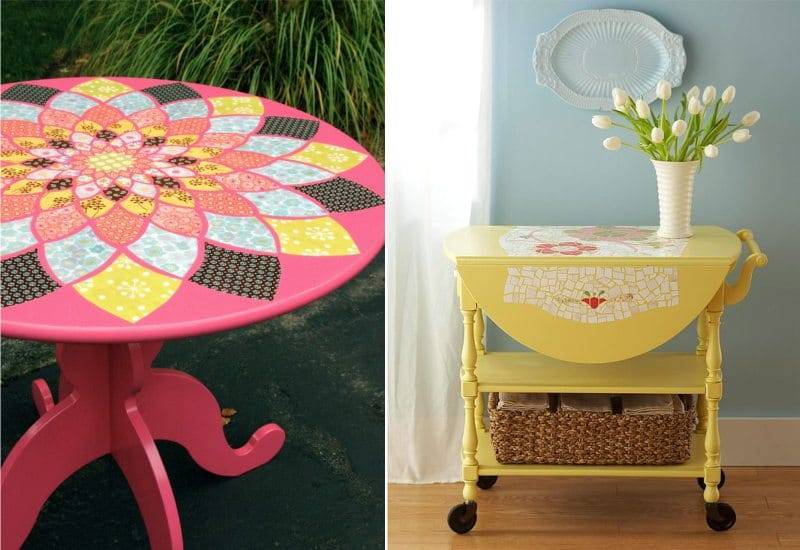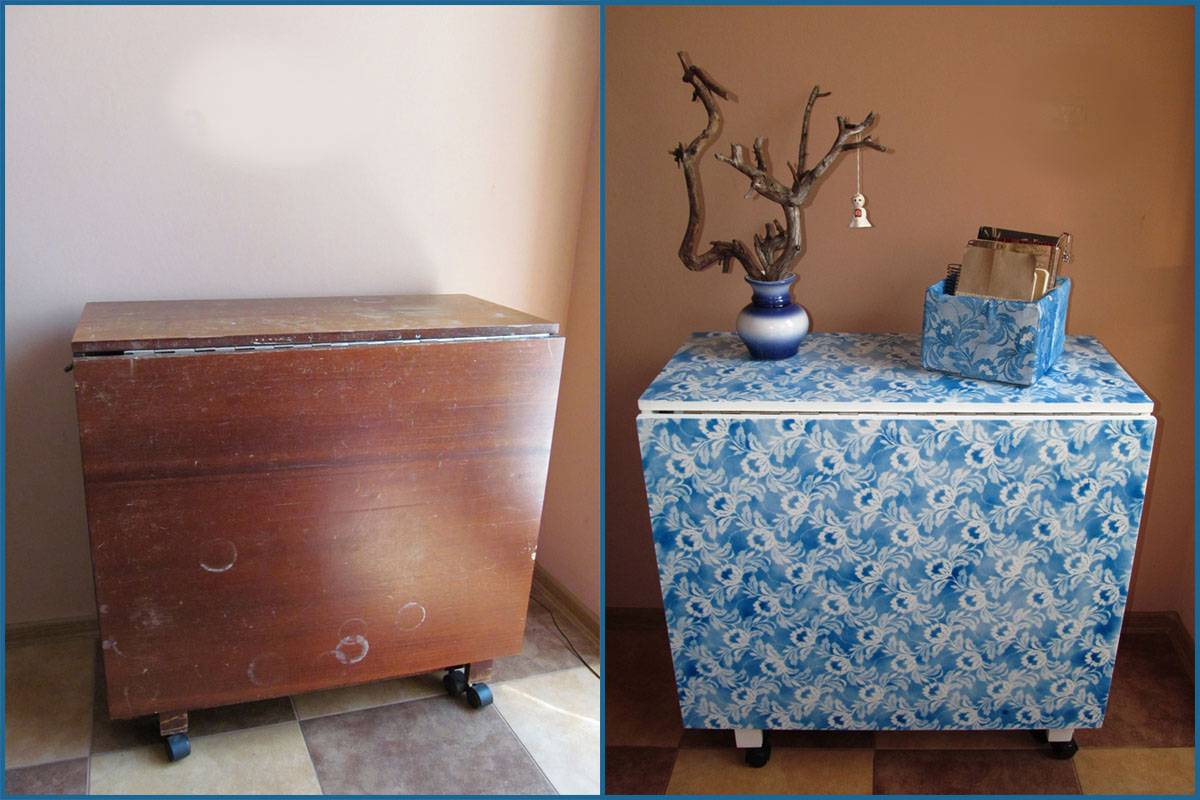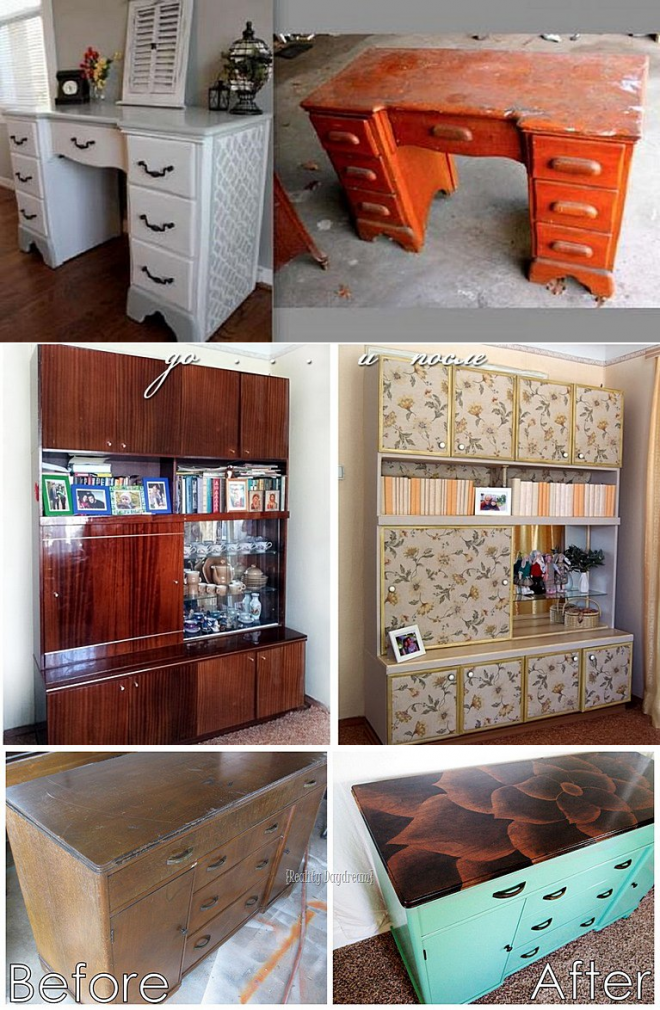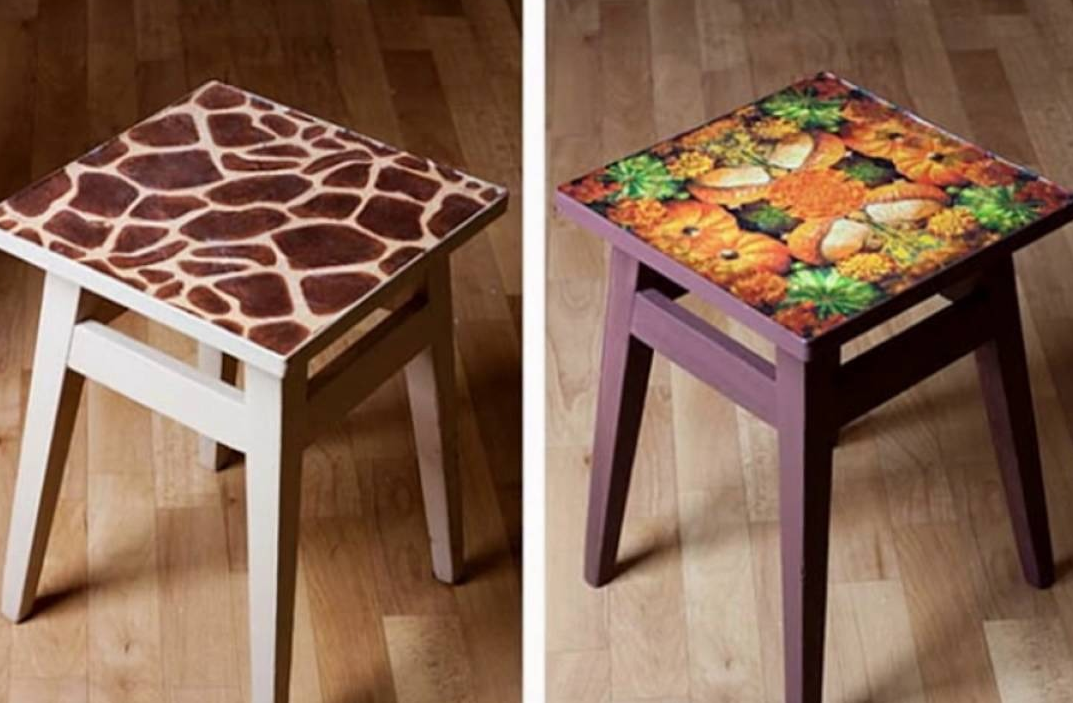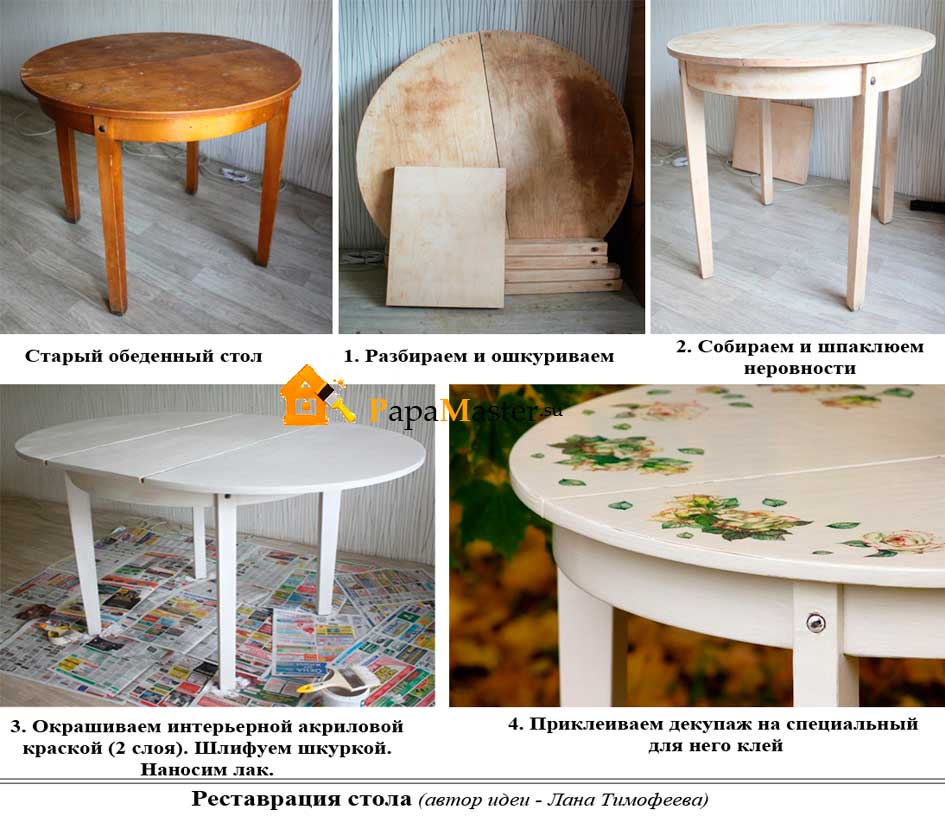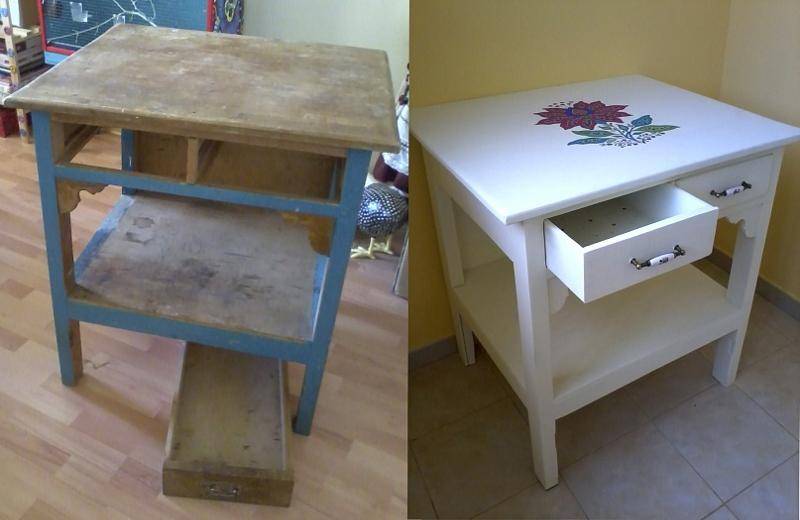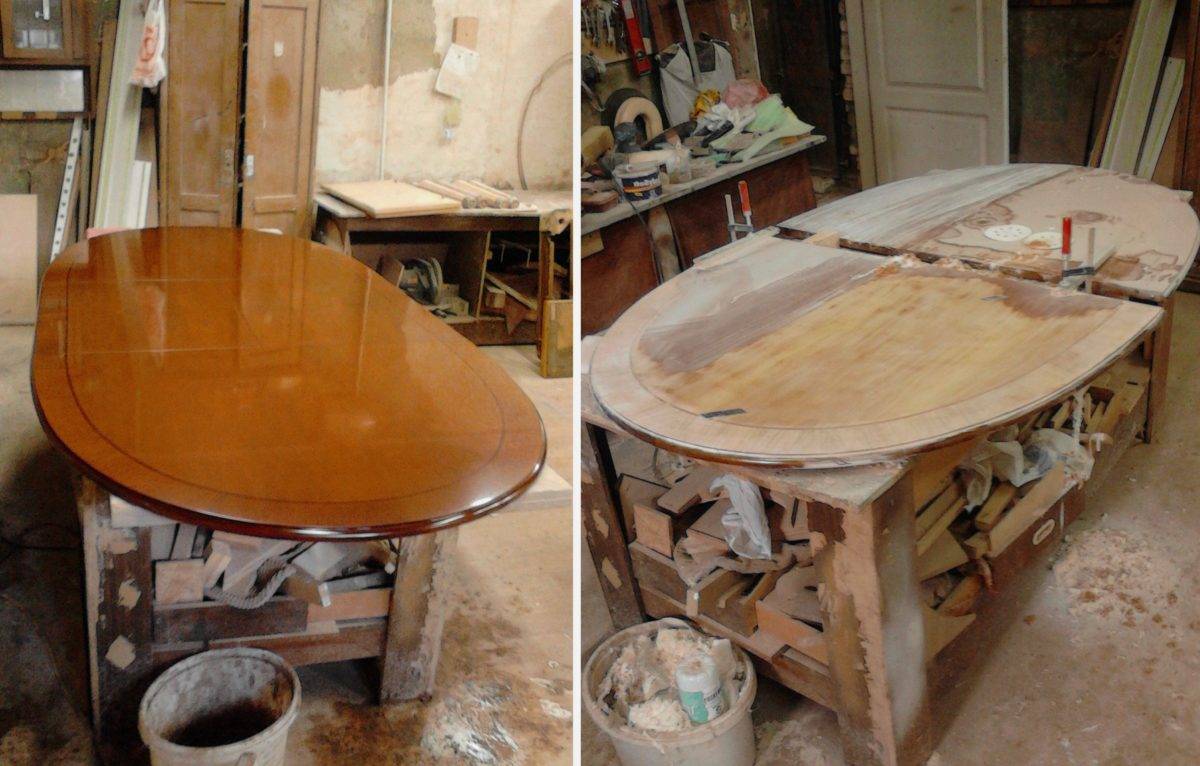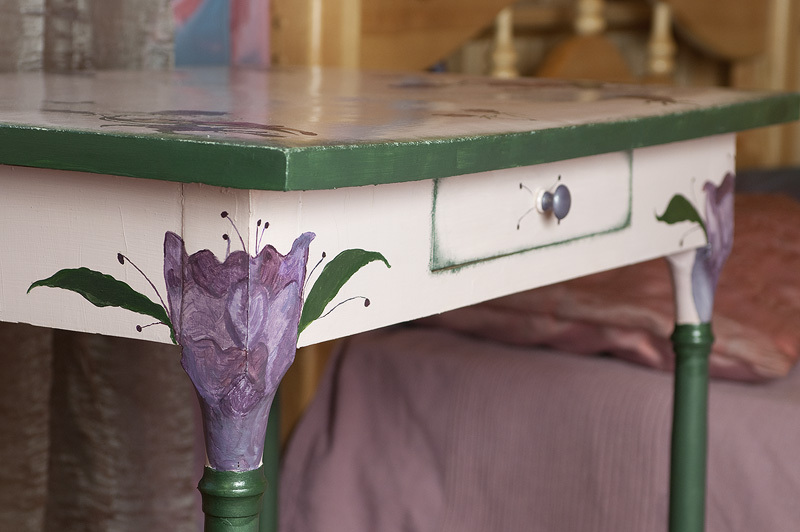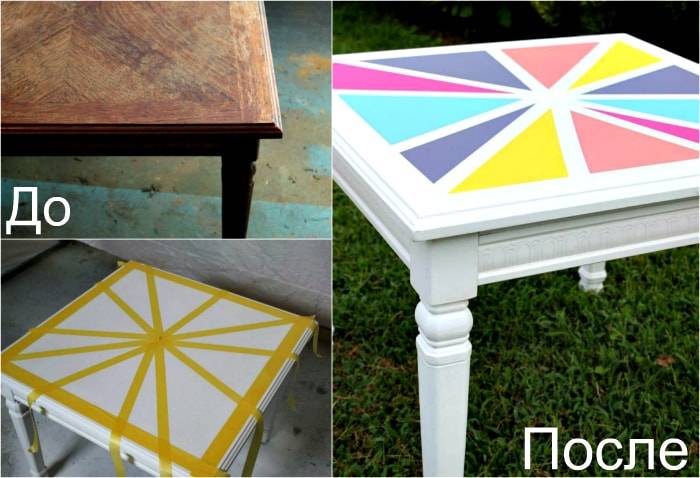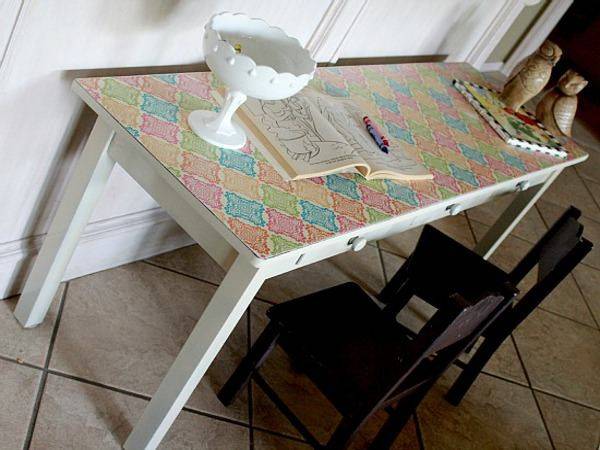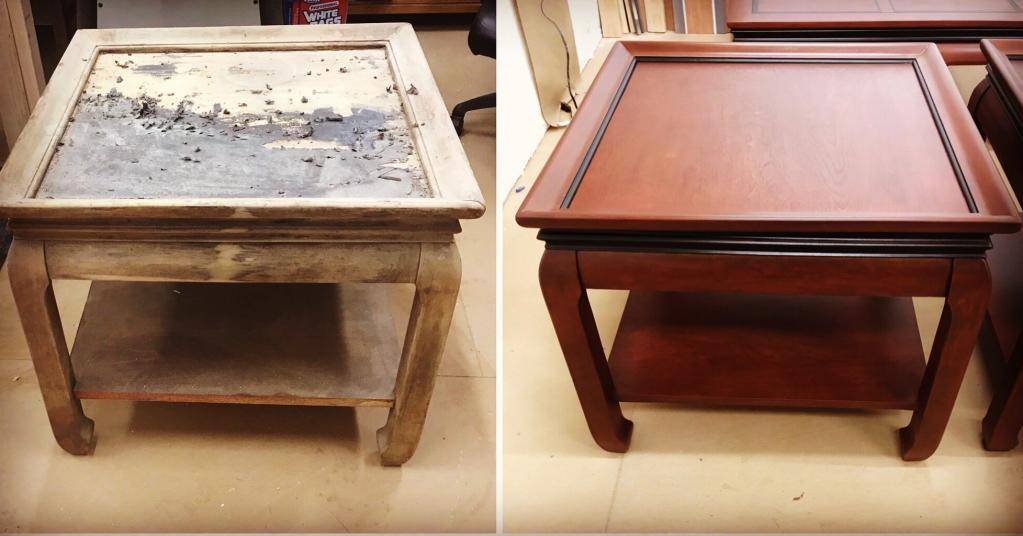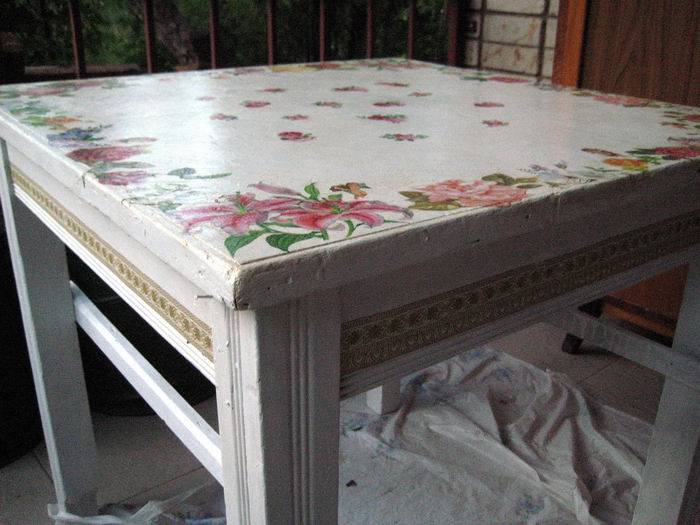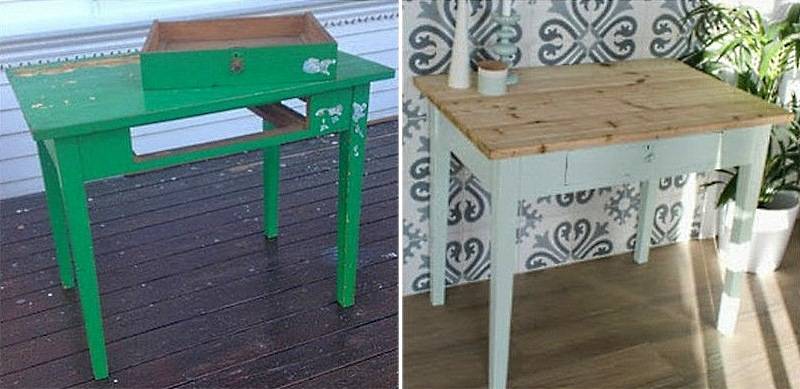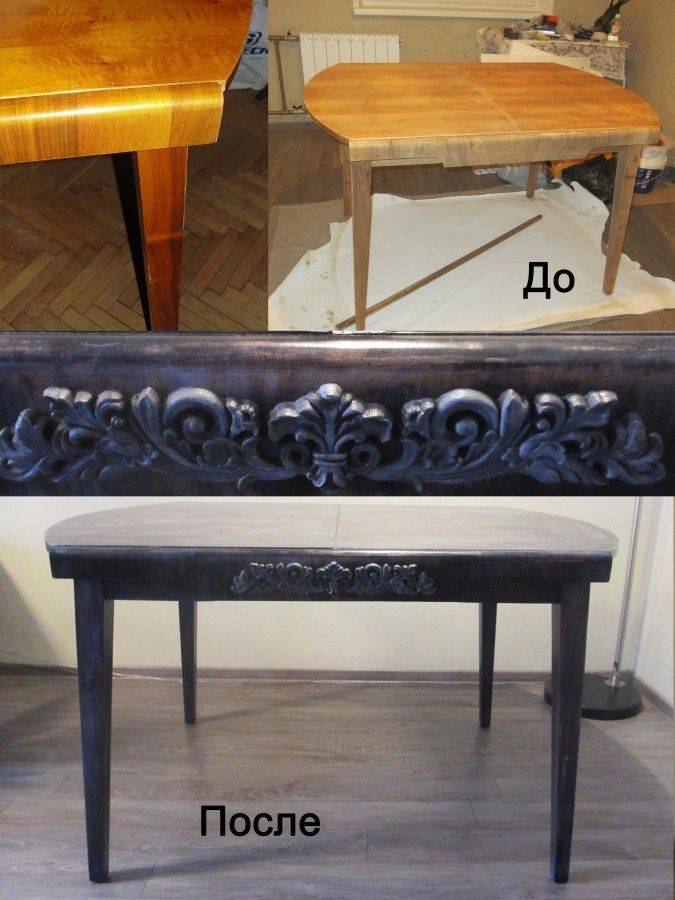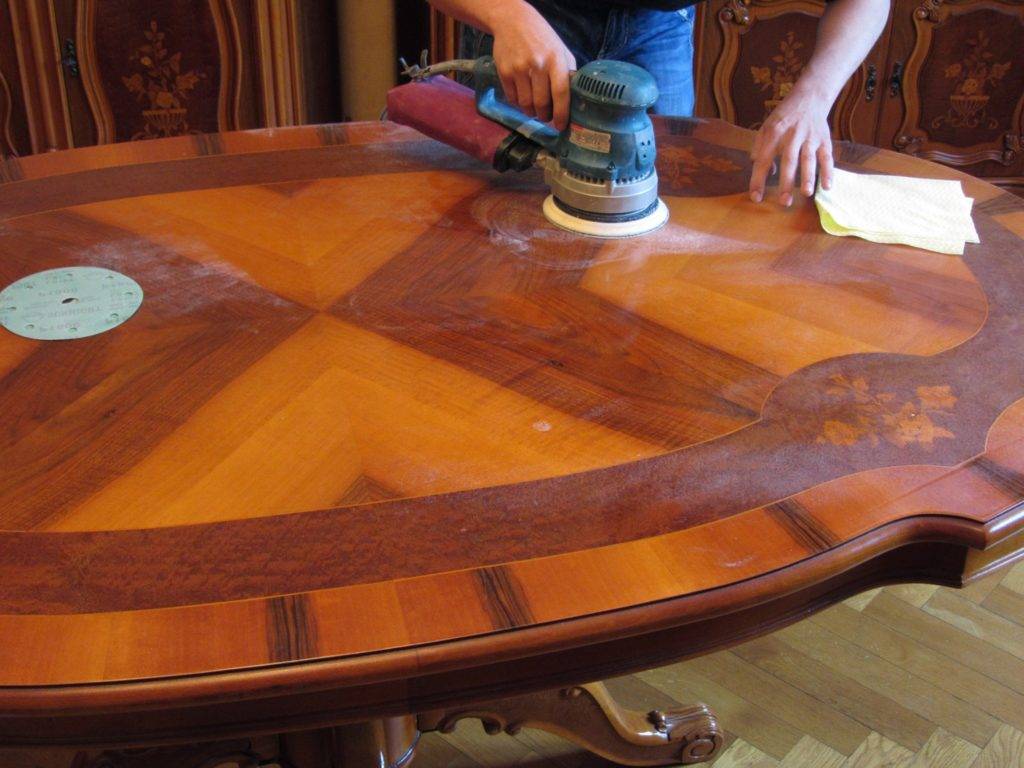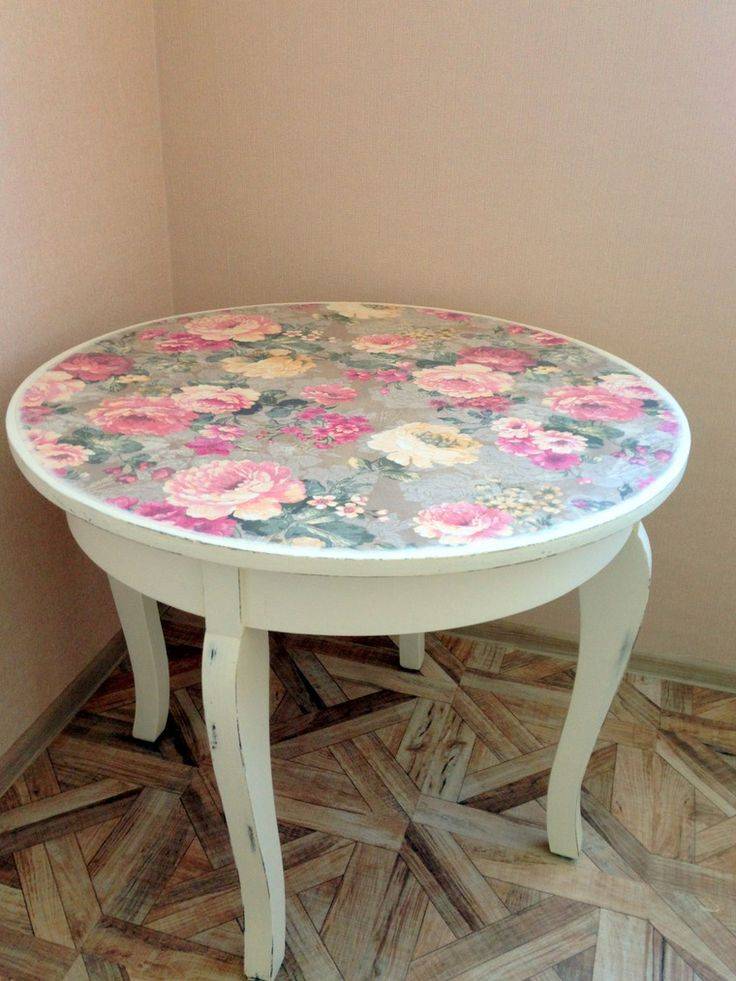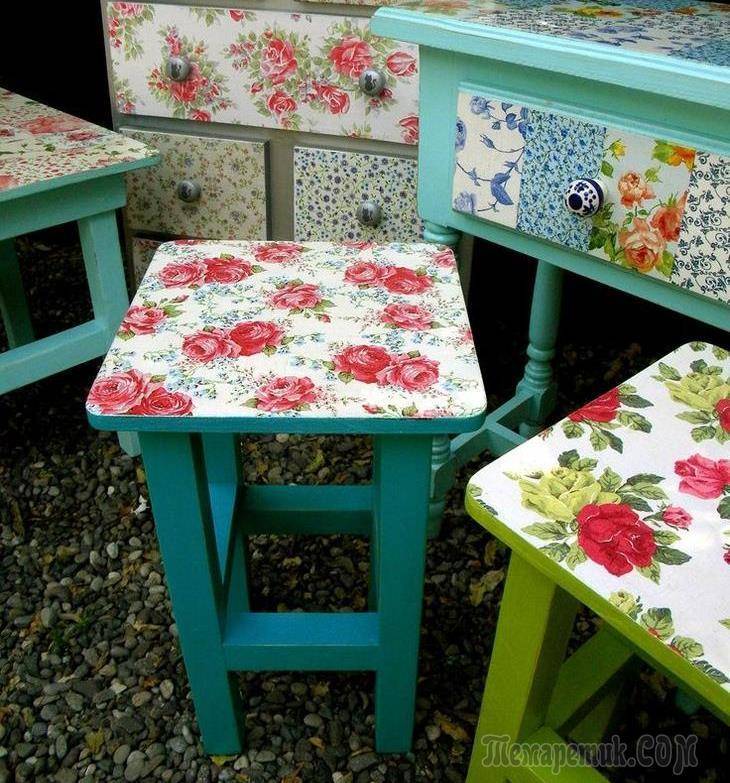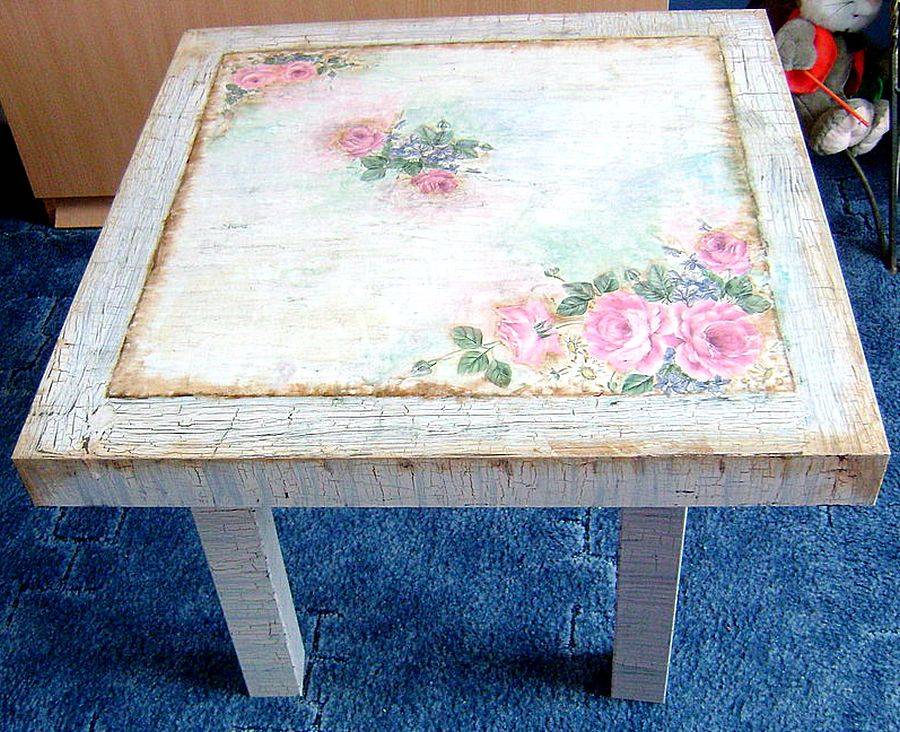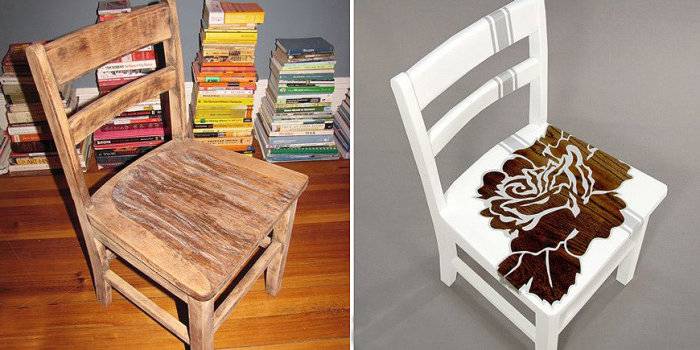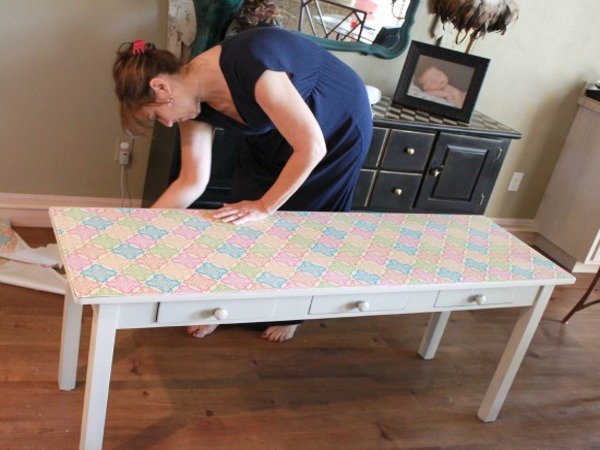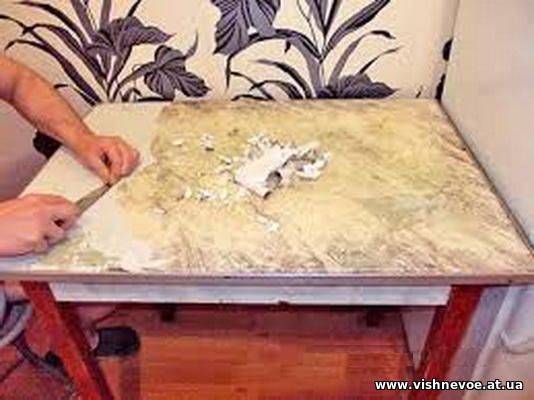Stages of restoration
Inspection
We examine the table and determine which defects are present on the product. It can be:
- scratches and dents
- erased varnish,
- damaged legs that wobble.
If the legs are very loose, it is better to disassemble the table and carry out further restoration disassembled.
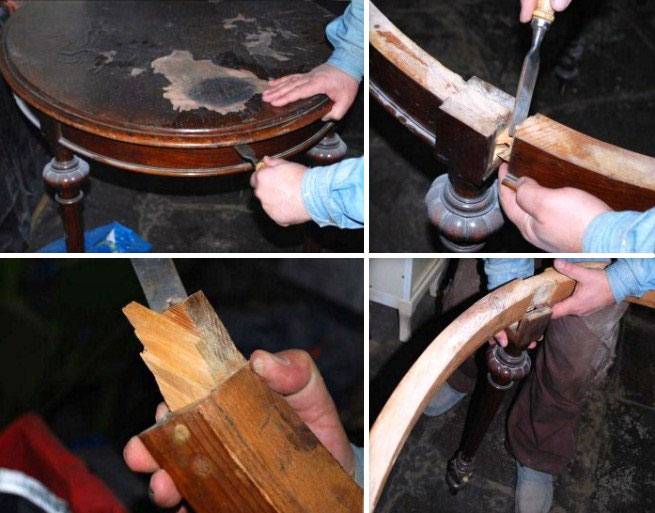
Grinding
The purpose of this process is to remove the old paintwork and prepare the table for subsequent refinishing.
For grinding, we need a sandpaper. We begin to grind the product with a coarse-grained sandpaper, we go in a circular motion throughout the table: along the table top, legs and tsarovy belt.
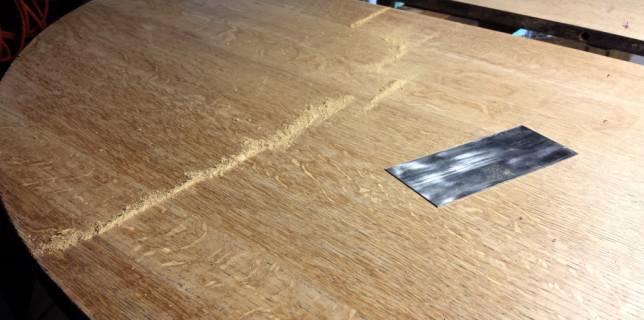
Further, for better removal of old varnish and leveling the surface, you can use a finer sandpaper. If you have a sander, the sanding process will be much faster.
When sanding, it is important not to overdo it and not sand down to holes.

After grinding, be sure to clean the product from dust
Impregnation, restoration of countertops
If the table is made of natural wood, it is better to treat it with a special impregnation, which will protect it from pests and diseases.

Leave the parts to dry for a while. Then we cover all the cracks with putty. After complete drying, the putty is again sanded with a fine sandpaper
If the table is made of chipboard, you need to inspect the table top and determine if there are bubbles on the surface. If there is, then the veneer is peeling.
Such a defect can be corrected by making an incision on the surface of the bubble with a thin knife. After that, you need to apply glue with a syringe into the hole. Then we take a regular iron and iron the table surface until the veneer sticks.
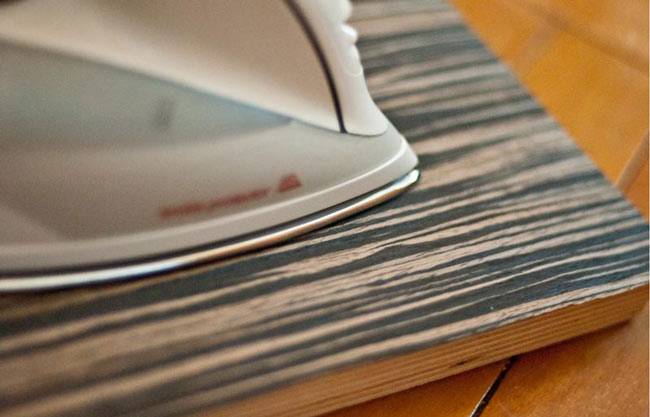
If the veneer has broken off at the edges of the countertop, we can cut a patch from a new piece of veneer, apply glue to it, attach it to the damaged part and iron it again.
Painting
Let's start painting. We take paint or varnish, depending on your taste, brush and paint. You may need to paint in two or three coats.
This is determined in the course of restoration work, depending on what kind of appearance we want to get. Let the paint dry well.
Assembling the table
When all the parts have dried well, we proceed to the assembly of the product.
So that the legs do not stagger, when installing into the grooves together with the legs, we insert thin pieces of veneer or matches. Legs with a side belt are assembled with glue.
We leave the assembled furniture until the glue is completely dry and the parts set.
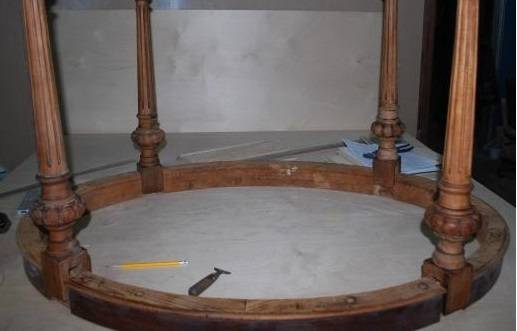

It may be that the old table is solid, does not stagger and the legs do not need repair. Then it is better to carry out all stages of restoration assembled. It makes no sense to disassemble it.
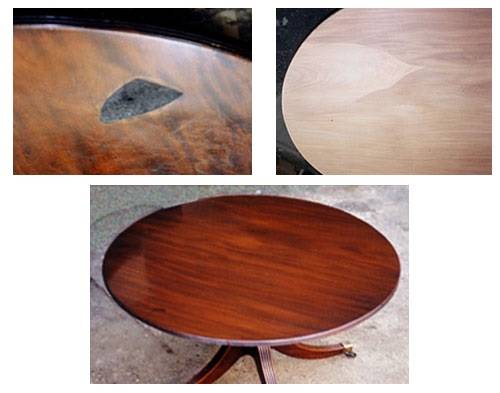
So we examined the main stages of the restoration of a wooden table. We wish you to try to make repairs with your own hands and be satisfied with the result.
Good luck!
What materials are needed to restore
Undoubtedly, tools alone are not enough to fully restore the table. You will also need materials: for processing wood, sealing defective areas, cracks, finishing. These are putties, impregnations, stains, glazes, paints and varnishes. In critical situations, you will have to resort to replacing individual elements, making them out of wood, and then gluing them in.
Putty
A special material that is used to seal deep cracks, cracks in countertops, frames and legs. Most often it has an acrylic base, dries quickly. The hardened putty can be easily processed with sandpaper.Certain types allow you to mask the material for wood types (pine, ash, oak). They make the place of the table repair unobtrusive.
Special products for wood
This group of materials includes impregnations. Including those that prevent rotting, destroy the fungus (if the table has been in a damp room for a long time, in the attic).
Varnish
Varnishing is used if you want to emphasize the noble structure of wood. In all the rest, it is successfully replaced by coloring. The use of varnish is justified if the table is made of natural wood. Modern paints allow you to achieve an equally spectacular appearance of the table (if you choose them correctly).

Dye
The painted surface of the table is not afraid of water, it looks good. When using several areas of different colors, bright mosaics achieve a complex range. Just like on expensive and rare tables.
Glue
In case of serious damage to the tabletop, individual elements of the gluing of new parts cannot be avoided. For this, two-component mixtures, PVA or polymer, are used. The main thing is that after gluing there are no unaesthetic stains, traces on the surface.
Wooden canvas
Wooden inserts are used in especially difficult situations when it is impossible to do without "prosthetics". In this case, the grade and color of the material (wood), its texture must match.
Option 1. Coating with paint and varnish
This option is great for beginners; it does not require any special knowledge or skills from you.
Sequencing:
- Repair the table and prepare the surface.
- Stir the paint thoroughly.
- Use a soft brush to gently paint along the grain. You need to start from the table top, and gradually go down. This is necessary to avoid paint drips.
- Apply the paint in two layers and wait until it dries.
- Apply varnish in the same way. The varnish can be from one to three layers, depending on what degree of gloss you want to get in the end.
- Instead of paint, you can use solutions that give furniture surfaces a gold or silver color.
A simple do-it-yourself table restoration for beginners is now complete.
And since there are many different technologies for restoring and remodeling furniture, we will consider other options.
Restoration methods
An acquaintance with modern methods of its repair, as well as the look obtained after processing, will help to determine the best option for restoring the table. You can cover products like this:
- Using ordinary brushes (to create a perfectly flat surface or create a smooth transition from one color to another by mixing paints directly on the tabletop with a small brush).
- Through nets, tulle, stencils (for patterns and stylized spots on the surface).
- Craquelure compositions (allows for antique styling, giving the surface the appearance of cracked paint).
You can also glue the tables with different types of films, and carry out pasting with paper materials. All of the options discussed are more applicable to wood furniture, but some of them are also suitable for the restoration of plastic products.
Required materials and tools
To restore the chairs, you will need the following:
- quick-drying varnish (transparent or tinted);
- dye;
- upholstery fabric;
- foam rubber;
- plywood;
- sandpaper;
- metal washers and bolts (screws);
- springs (for a specific type of chair).
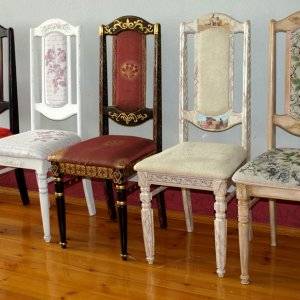
Emery paper is required in order to clean the surface of the furniture from irregularities, chips and cracks in the varnish.
The fabric is selected to be resistant to abrasion and mechanical stress, sufficiently dense. Tapestry, flock, matting, etc. will do. For an antique chair, choose a decorative material with embroidery.
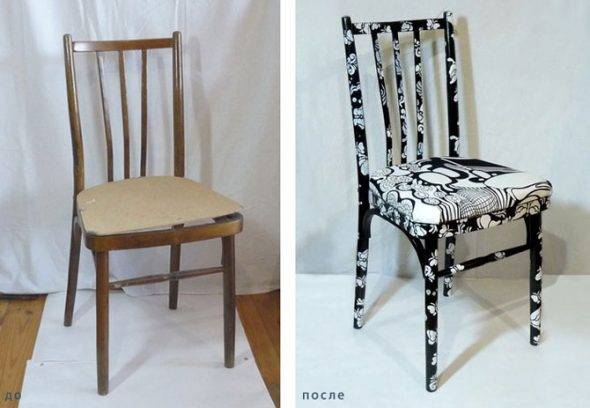
Updating furniture on your own will be much cheaper.
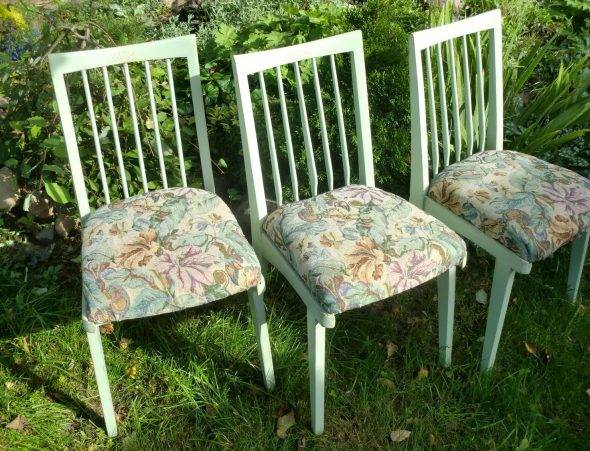
Select a wooden base according to density and texture in advance, cut it to size and use a template to draw up the desired pattern.
Emery paper is required in order to clean the surface of the furniture from irregularities, chips and cracks in the varnish. The chair (wood structure) must be completely sanded for smooth application of the laminate.

For major repairs, the chair can be disassembled, the broken off parts can be replaced with new ones and fastened with bolts or screws.
To upgrade a chair, you need tools:
- scissors;
- roulette;
- a hacksaw for wood (cut off the excess plywood under the seat);
- screwdriver;
- screwdriver.

For greater security, you can add a little all-purpose adhesive to the grooves.
For major repairs, the chair can be disassembled, the broken off parts can be replaced with new ones and fastened with bolts or screws. Seat frames also often require restoration.
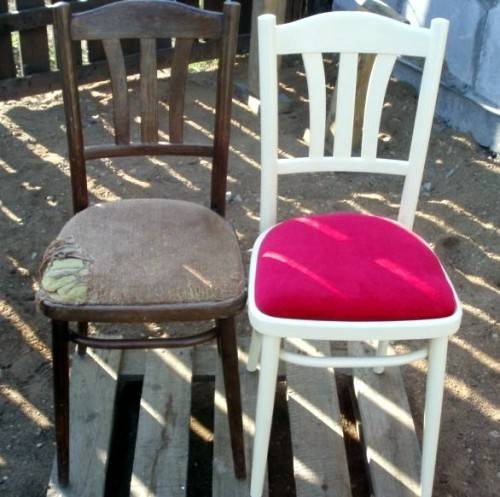
Seat frames also often require restoration.
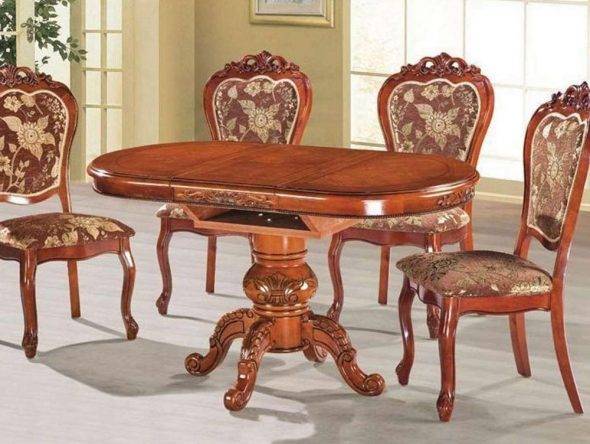
A Viennese chair or whatever looks best in this design.
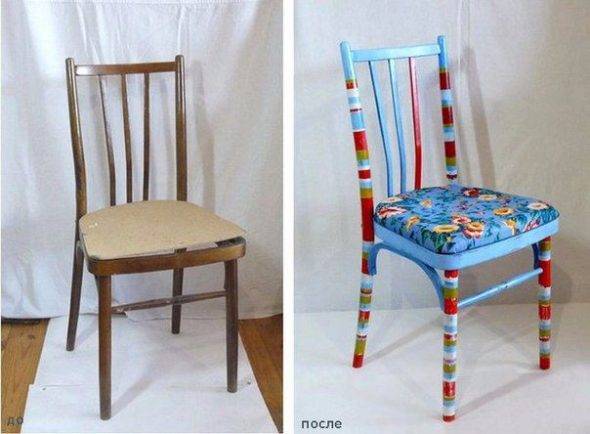
A leaky seat is refurbished by replacing the lamella base and / or completely refurbishing the upholstery.
Restoration of an old furniture interior
If the owner of old furniture has no desire to restore it using conventional methods, then there is an opportunity to make a masterpiece out of it. Today, professionals use a variety of techniques that can be used to create something extraordinary, as opposed to conventional painting or varnishing.
Painting with paints
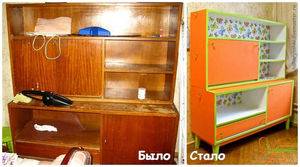 Many wondered how to restore an old table with their own hands. To do this, you can simply paint it. Furniture painting is rightfully considered the best and cheapest way to restore furniture. First you need to apply a monochromatic base on which you could do the decoration. You can decorate a chair or table, for example, with flowers. The main thing is that the drawing fits the style of the room. Patterns can be found on the Internet. Such furniture is perfect as decorations, for example, in a buffet.
Many wondered how to restore an old table with their own hands. To do this, you can simply paint it. Furniture painting is rightfully considered the best and cheapest way to restore furniture. First you need to apply a monochromatic base on which you could do the decoration. You can decorate a chair or table, for example, with flowers. The main thing is that the drawing fits the style of the room. Patterns can be found on the Internet. Such furniture is perfect as decorations, for example, in a buffet.
Decoupage ornament
You can also do this kind of decoration with children. It is simple at its core. Various patterns can be cut out of fabric and paper. After that, all the details, as well as the object of decoration as a whole, are varnished. You can also make do-it-yourself decoupage at home, for example, put on a regular fabric cover.
Craquelure coating
Perfect for restoring an old cabinet. Two technologies are used here: varnishing and decoupage. Using this method, you can give the furniture an antique look. First you need to apply a regular layer of varnish, and while it is not dry, apply craquelure, which will form an imitation of cracks, like in antique furniture.
Veneer finish
 Veneer looks like small and thin pieces of wood of different species and colors. Decor elements are cut from sheets of such veneer for furniture restoration. They are glued to the surface with PVA glue. You need to prime it in advance. The combination of several techniques together looks very cool.
Veneer looks like small and thin pieces of wood of different species and colors. Decor elements are cut from sheets of such veneer for furniture restoration. They are glued to the surface with PVA glue. You need to prime it in advance. The combination of several techniques together looks very cool.
As you can see, old furniture, which has remained strong, but has aged a little, lends itself well to restoration using various methods and techniques. It can not only be repaired, but also given a completely new look.
Originally posted 2018-03-03 06:27:11.
Finishing touch
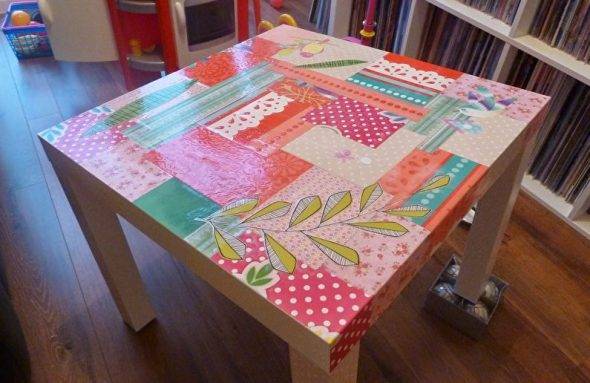
Decor of an old table using decoupage technique
The final stage in the restoration of a wooden table is decoration. You can again take up the brush and, using various stencils or masking tape, apply an applique to the table surface.
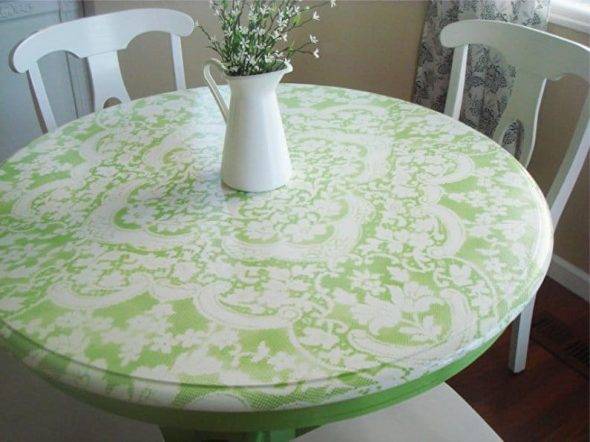
Painting the table through tulle should be done over the base layer, with a pigment of a contrasting color
For those who can draw well, the image of their own masterpiece on furniture, which will remain for many years, is suitable.
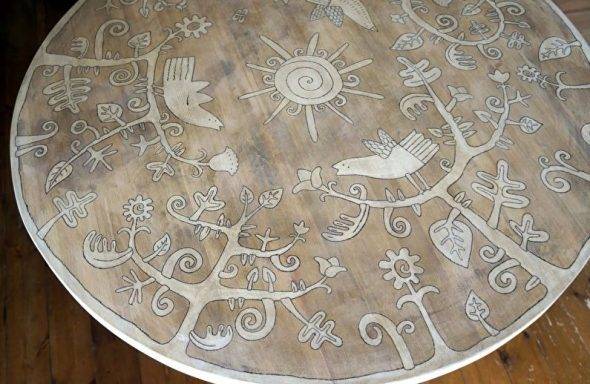
A table with artistic painting will perfectly complement the interior in ethnic or rustic style
The pattern on the countertops can also be created using mosaics or beading.The latter is used in work when the goal is to imitate one of the noble metals - gold, silver or bronze.
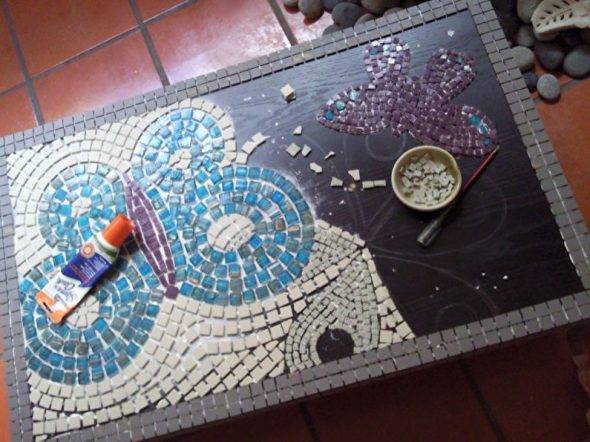
Create a painting from small fragments on the surface of the table

Potal (gilding) is a wonderful decoration for a table in a classic style
Surface coating with varnish
So, the stain has dried, and you can safely varnish the table. The choice should be made in favor of colorless furniture varnish (not matte). It should be applied in one direction.
Let each layer dry for the time allotted by the instructions for use. There is no need to rush, as premature application of the layer can lead to the appearance on the surface of the table "waves" from the previous layer.
If small dots appear on the lacquered surface (and this, alas, often happens even with experienced restoration masters), they should be cleaned with sandpaper. And do not be scared by the white spot that has appeared in the place of cleaning. At the last stage, you will make the table perfectly flat with your own hands. After all, you have to polish the surfaces. You can use any modern polish that is chemically combined with the previously used varnish. But ideally, you should always strive to use old methods, so you can safely recommend using ordinary foundation.
It should be warmed up and applied to the surface of the table, rubbing it into the wood in a circular motion using felt. The work is hard and monotonous, but the foundation is worth it. She will help you finish restoring the table on a very pleasant note: the smell of natural foundation will plunge you into the world of childhood, and in the future you will come with great desire to the table with such a familiar smell. Perhaps you still want to restore old things.
Decor options
Restoration and subsequent decoration of a table is a very time-consuming process. But the result is worth it, because you can get an exclusive designer item with which memories are already associated. Furniture decor can be completely original and at the same time very organically fit into the concept of using the object and the room.
A laconic design is suitable for a book-table or folding table. It can be dyed one or two colors. And you can give nobility and accentuate the natural structure of the tree.

The sliding table can be decorated with drawings that may appear only when the tabletop is disassembled as much as possible. And of course, if this kind of table is used as a dining table, you can use kitchen themes in its decor - images of food, fruits and vegetables, cutlery. The kitchen table can be decorated with tiles and mosaics. This will be a very practical solution.
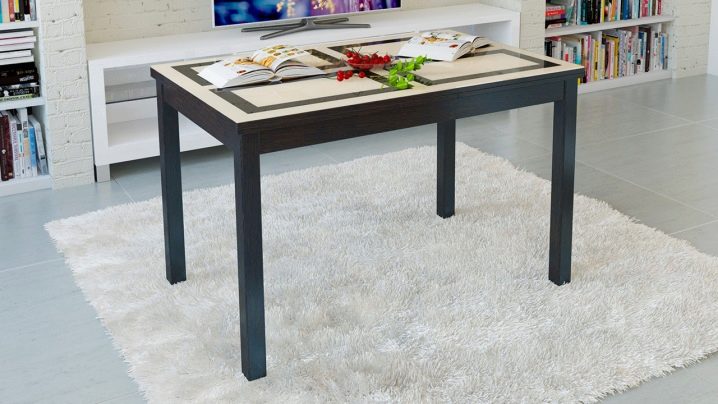
For a dressing table, due to its functionality, delicate pastel shades and light colors, as well as all kinds of "girly" prints (flowers, cosmetics, patterns) are suitable.
The coffee table can be painted in a rich color or provided with a bright pattern.
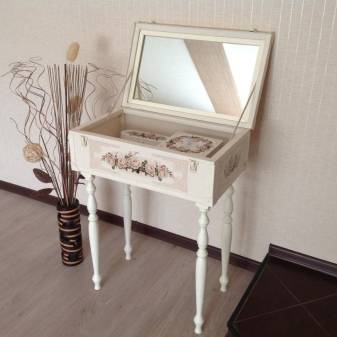
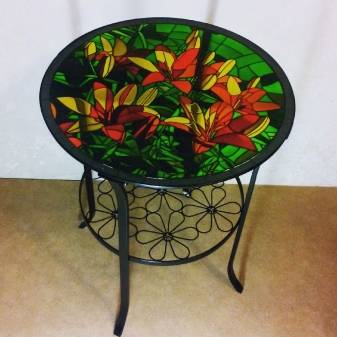
For the children's table, you need to use only high-quality finishing materials. And you can decorate it with a variety of animals, cartoon characters.
A practical solution for the student will be to create a "cheat sheet" table, on the surface of the tabletop of which you can apply a variety of didactic materials (rules, diagrams, formulas).
The use of a computer table-pedestal assumes high exploitation. Therefore, materials must be selected appropriate - not easily soiled (the computer "attracts" dust), wear-resistant (especially to the effects of heat).
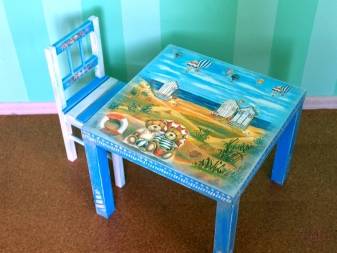
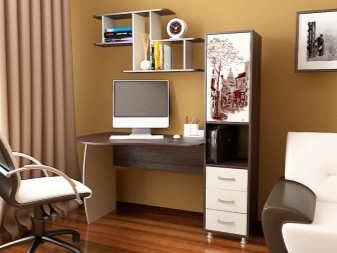
Creative ways to update
A lot of people are racking their brains over how to update old tables that look bleak. There are many ways to decorate the countertop of a kitchen table or any other:
- Painting. A very simple restoration method. Different types of paints are used, for example, acrylic, alkyd or enamel.
- Artistic painting. Quite a difficult way that requires drawing skills.You can use a stencil, this greatly facilitates the task.
- Craquelure. This method is a decoration by applying a finish that simulates an old cracked coating. This is done using special chemical mixtures.
- Mosaic. You can make it with smalt, but it is very expensive. Better to use broken tiles. For gluing, use a universal glue.
- Decorative film. It is glued on after polishing and cleaning the surface. With this technique, an old coffee table can be turned into a trendy piece of furniture.
- Pasting with decorative tape. After polishing and processing with alcohol, adhesive tape is glued. Then the place of pasting is rolled with a special roller.
- Epoxy treatment. This solution turns into plastic after being applied to the surface. With its help, decoration takes place with the addition of a variety of patterns.
- Application of varnish or stain. This is the simplest way to decorate, which even a beginner can handle. Moreover, it will preserve the natural texture of the wood flooring as well as provide protection against moisture and burnout. Most often, this method is used to update the old kitchen table.
- Painting through tulle. To do this, you need to find a piece of old tulle. Next, you need to paint the table white. After the paint has dried, lay the tulle on the surface of the furniture in such a way that the arrangement of the pattern looks as beautiful as possible. Fix the fabric so that it does not budge during painting. Then you need to take a can and start painting. The tulle can be removed after 15 minutes.
- Gilding. With the help of a transfer bead, you can achieve a beautiful gilded effect. This operation is carried out in the same way as staining, using a stencil.
In order to restore a coffee table with your own hands, it is best to use mosaic decoration, painting, burning or varnishing. To "revive" a faded writing desk, you can choose staining or varnishing. There are quite a few design methods for the kitchen table: coloring through lace or tulle, decorating with ceramic tiles or using decoupage.
Garden tables are best decorated with tiles or mosaics, especially if they are outdoors. If you need to decorate a table for children's creativity, you can be creative and paint each leg in a different color - you get a bright and cheerful piece of furniture.
Summing up all the recommendations, it is safe to say that the restoration of outdated furniture can be done independently. Anyone who has ever held tools in their hands can turn an awkward shabby table into a real work of art. Of course, this will take time and patience, but the result will be worth it.
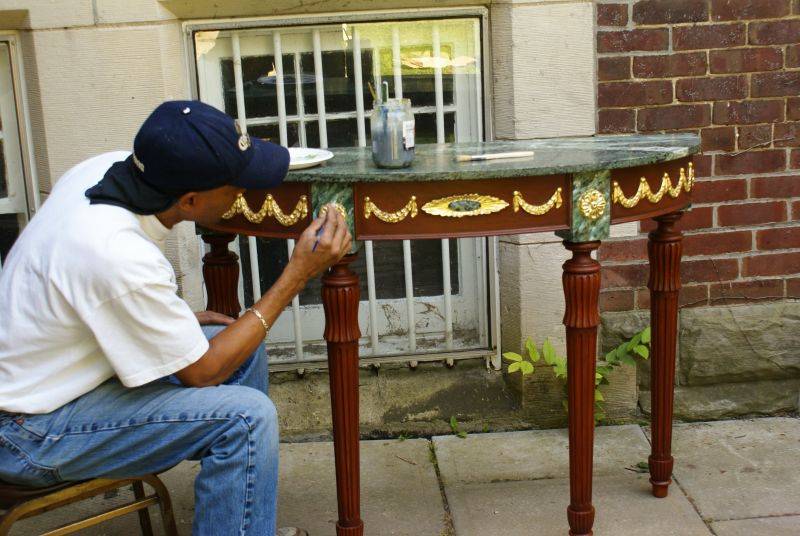 Painting
Painting
 Craquelure
Craquelure
 Art painting
Art painting
 Mosaic
Mosaic
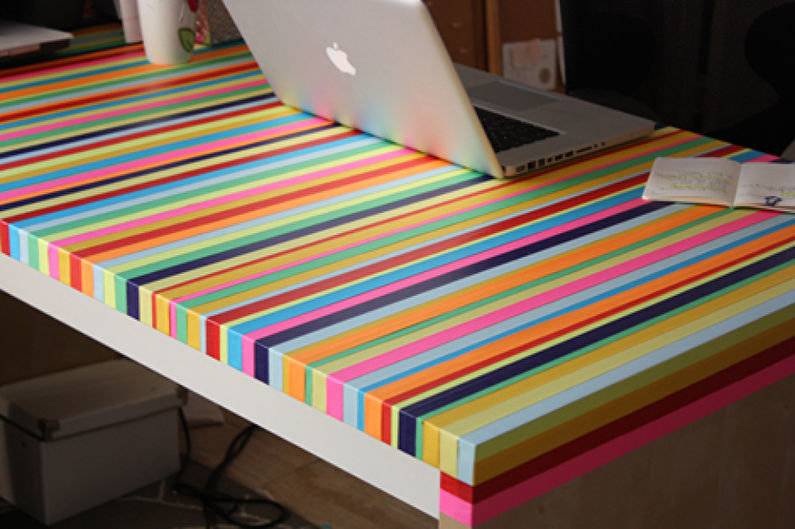 Decorative tape
Decorative tape
 Decorative film
Decorative film
 Epoxy treatment
Epoxy treatment
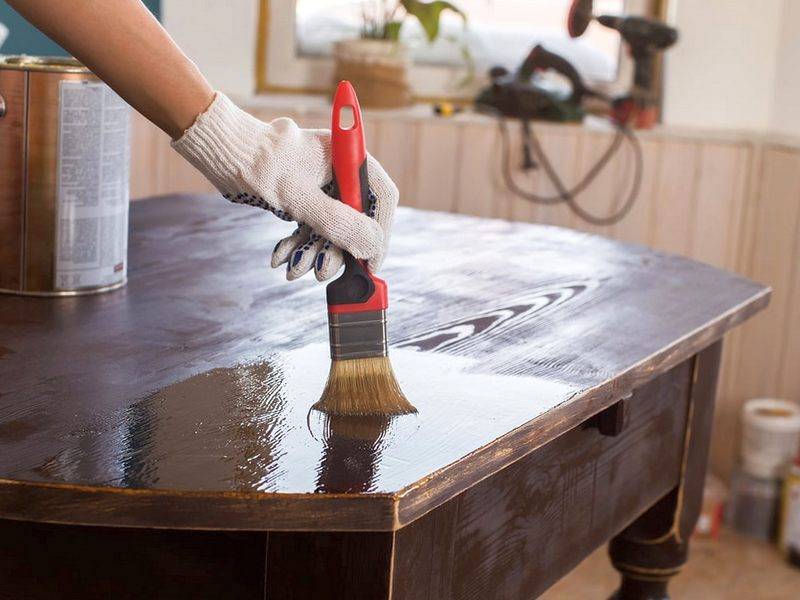 Applying varnish or stain
Applying varnish or stain
 Painting through tulle
Painting through tulle
 Gilding
Gilding
Stages of restoration
Acclimatization. So that after restoration the elements of wooden furniture do not deform, you need to let it "get used" to its environment
Air temperature and humidity are important for wood

The optimum temperature for the room in which the furniture restoration work will take place should vary from 18 to 25 degrees, the air humidity should not exceed 75%
You should also pay attention to the detrimental effects of direct sunlight and heat from radiators.
Dismantling of elements. For better processing, it is better to disconnect all the pieces of furniture from each other and work with them separately. You need to use tools as carefully as possible, without damaging the tree.
If it is important to keep the elements and the fastening system in their original form, it is better to disassemble them and lay them out in order.

Cleaning.Each element should be cleaned in the most gentle way - with a soft brush wrapped in a cloth, a vacuum cleaner and non-aggressive chemicals.


Removing dents, scratches. To do this, use special wax pencils, "liquid wood" or steam from an ordinary teapot. These options are suitable for small, shallow damage, otherwise the entire module may need to be replaced.

Repair of fasteners. Full or partial replacement of fasteners is implied. Restoration of the top layer of wood. To do this, you may need to glue a sheet of plywood onto the old surface.

Coloring. First, a primer is made, then painting with alcohol-based paints. Varnishing and polishing. Decoration and deliberate aging of furniture. Assembly of elements into a finished product.

If everything is done carefully and correctly, the value of the furniture after restoration with your own hands will not be lost. Work should be carried out without haste, carefully, using all the recommendations of the manufacturers of chemical agents and maintaining the required time for their exposure.
Restoring furniture from chipboard with your own hands will allow you to step by step control the entire process, make adjustments at any stage and end up with a completely exclusive item.

Not having extra funds for new furniture, you can easily restore the one that is available in your home, from your parents, from your grandmothers. Soviet furniture is famous for its quality, and the atmosphere and comfort that familiar interior items create from childhood cannot be bought for any money.

How to upgrade a plastic table
Most plastic furniture loses its original attractiveness over time, even if used in home (not balcony or country) conditions. For example, due to minor mechanical damage, it can become covered with scratches, abrasions. But the constant ingress of sunlight can cause the plastic to burn out and turn yellow. There are two ways to update such tables:
Repainting.
Ideal for products with flat worktops. Initially, the surface of the plastic is processed with fine abrasive sandpaper, then degreased, covered with a primer. The final stage will be the coating of the product with aerosol paint.
Decoupage.
The best solution for tables with curly projections or recesses. Initially, with the help of fine abrasive sandpaper, the entire tabletop, frame is cleaned. Then it is degreased. The napkins chosen for decoration (or paper, thin newspaper) are glued to the decoupage glue. After the glue dries, the product is covered with a transparent varnish.

Updating the countertop with decoupage
If you do not want to be satisfied with what has already been achieved, or your table does not have serious damage, but just needs a small update, then you can decorate the table with drawings: paint it with acrylic paints by hand, use stencils and stamps, or update the table using decoupage. Perhaps, we will consider this very popular decor technique in more detail, because decoupage will not only allow you to budget and quickly transform the table or, for example, stylize it like Shabby chic (as in the photo below), but also hide some defects of the dilapidated surface.
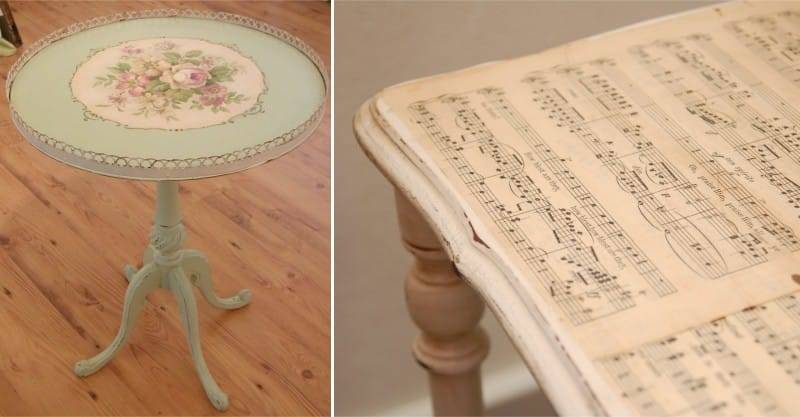
To update the table with your own hands using decoupage technique, you will need:
- acrylic primer and acrylic paints - if desired;
- putty for beige wood;
- sander and sandpaper of varying grain size;
- rubber spatulas;
- flat and artificial artistic brushes;
- matt or semi-matt wood varnish;
- decoupage napkins or decoupage card;
- scissors;
- PVA glue or special glue for decoupage.

Decoupage decor can be started either after priming and sanding (see step # 4 above), or after painting and varnishing. Then you should choose a picture - it can be any image on paper or table napkins, as well as special rice paper for decoupage.
First, markup is performed, lightly marking with a pencil the places where the images will be located. Put the cut paper image “face down” in a container with water and keep it for half a minute. Then the soggy image is laid out in the same way “face down” on a polyethylene file, and all excess paper layers are rolled off. Then the picture is carefully coated with glue and attached to the tabletop. The file is not removed - through it the image is smoothed as much as possible.
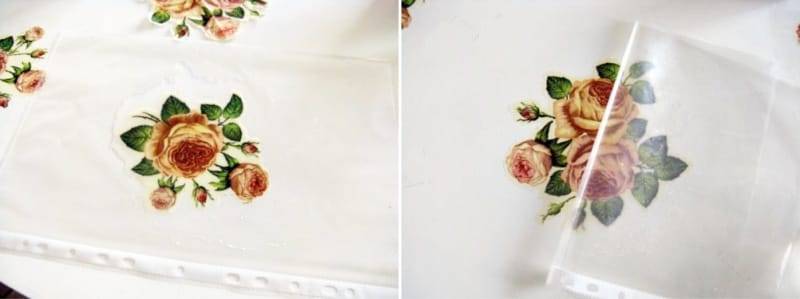
The surface around the pictures is decorated with paint. The final stage of decoupage is varnishing with acrylic varnish. After three days, the varnish will dry out and the table can be fully used.
Finally, a selection of photos for your inspiration.
Stages of restoration using decoupage technique
If we decide to restore the coffee table with our own hands, for decoupage we need the following tools and materials:
- Ruler
- Pencil
- Scissors
- Napkins with drawings or special pictures for decoupage (in our version these are photos)
- Water
- Polyethylene file
- Brushes of different thickness
- PVA glue
- Acrylic primer
- Furniture paints (in our version, acrylic white and black)
- Stencil (but you can do without it)
- Finish acrylic varnish
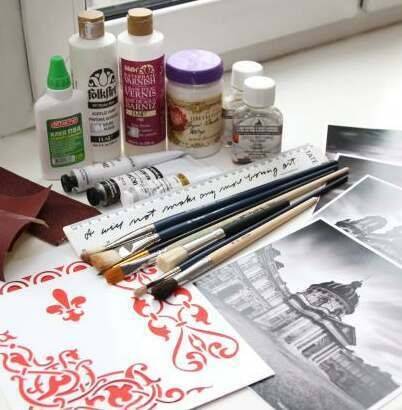
Table restoration process step by step
1. Now we can start decorating the coffee table. First, we need to apply some soil to the surface of the table. For this we use an acrylic primer. It is needed so that the paint that will be applied in the future is more evenly distributed on our product.
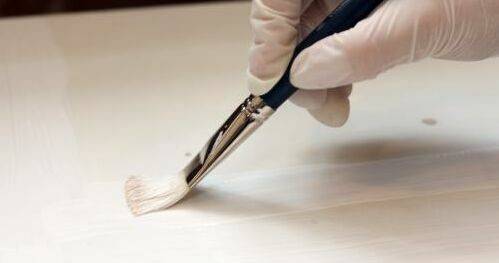
Primer gently with a brush and wait about half an hour for the primer to dry.
2. Next, take a ruler and a simple pencil and mark the table top so that you know where to glue the drawings.
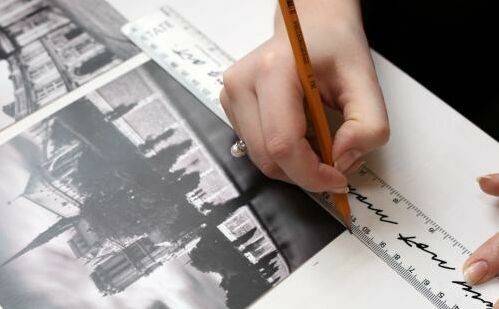
3. Now we take the drawing. In our version, this is a photograph. Dip the drawing in a bowl of water for 30 seconds.
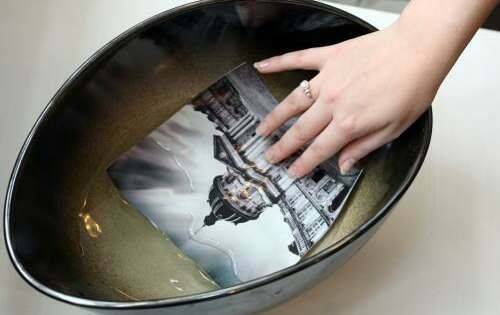
It is very important not to overexpose the drawing, as the paper may be damaged. We take the photo out of the water and put it face down on a plastic file
4. Since our photographic paper is thick, we carefully remove excess layers of paper so that the picture remains intact. Then with a brush we apply PVA glue to the photo.

5. Now carefully turn the file with the photo stuck to it, put it in the right place on the tabletop. Smooth the drawing through the file so that it lies evenly. And only after that we remove the file.
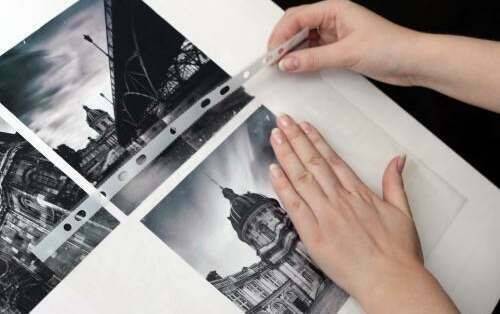
6. Take white acrylic paint and draw the fields along the contour of the drawings with a brush with stiff bristles. We try to keep the brush at one angle, as the bristles leave stripes. Then leave the table to dry for about 1 hour.
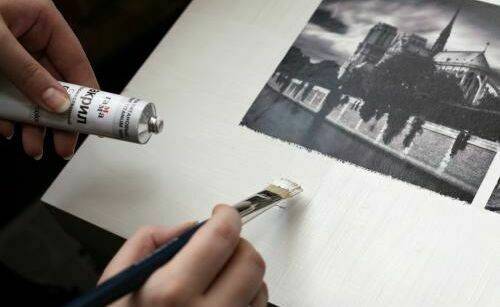
7. We decided to additionally decorate the corners of our table with a stencil. To do this, you need to attach the stencil to the corner of the table top and use a brush with black acrylic paint to go over it. We hold the brush in an upright position so that the paint does not flow under the stencil and does not smear.

8. The stencil can now be removed. We leave the table until the drawing dries for 1 hour.
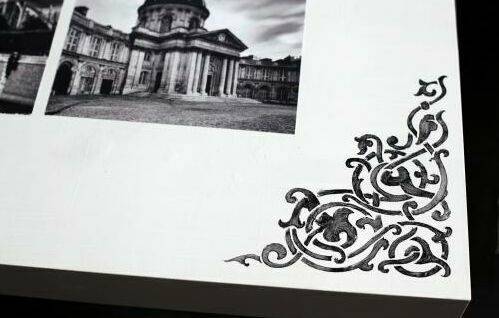
9. And finally, after the paint has dried, you can apply a finishing acrylic varnish to secure the drawings. We also apply varnish with a brush.

10. Finally, the restoration of the table is coming to an end. To use the table, it needs to dry. Dry in a well-ventilated area for 24 hours. After the expiration of this time, use it to your health!
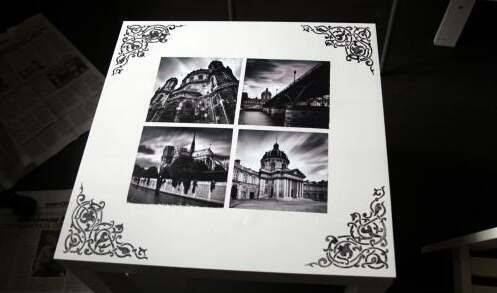
Now you know how to update a coffee table with your own hands, the photos presented above demonstrate what kind of masterpiece you can create yourself. Do not throw away old furniture, give obsolete items an opportunity to please you for some more time, give them a second life!
Conclusion
Do-it-yourself furniture renovation is not an easy, but still doable task. Therefore, before throwing away the old table, think about the possibility of restoring it. Even a shabby lacquered book-table can be repaired and decorated in an unusual way.If desired, the prepared furniture can be painted with different paints, varnished (glossy) or painted with matting compounds. Also, the updated table can be pasted over with films and stickers. There are a lot of ways to decorate products, you just need to choose the right one, based on the features of its implementation, the degree of complexity. You can update not only wooden, but also plastic, glass tables. Above, we described how to restore such products using simple materials and tools. By following step-by-step instructions and helpful tips, you can easily "bring back to life" even a very old, and at first glance, irreparable table.

